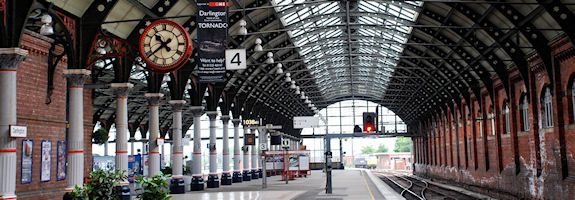
The first railway to pass through the area now occupied by the station was built by the Stockton and Darlington Railway, who opened their mineral branch from Albert Hill Junction on their main line to Croft-on-Tees on 27 October 1829. This branch line was subsequently purchased by the Great North of England Railway a decade later to incorporate into their new main line from York which reached the town on 30 March 1841.
A separate company, the Newcastle & Darlington Junction Railway continued the new main line northwards towards Ferryhill and Newcastle, opening its route three years later on 19 June 1844. This crossed the S&D at Parkgate Junction by means of a flat crossing which would in future years become something of an operational headache for the North Eastern Railway and LNER.
The original Bank Top station where the two routes met was a modest affair, which was rebuilt in 1860 to accommodate the expanding levels of traffic on the main line. By the mid 1880s even this replacement structure was deemed inadequate and so the NER embarked on a major upgrade to facilities in the area.
This included an ornate new station with an impressive three-span overall roof on the Bank Top site, new sidings and goods lines alongside it. The new station, with its broad island platform cost some £81,000 to construct and became a busy interchange on the main East Coast route, thanks to its rail links to Richmond (opened in 1846), Barnard Castle & Penrith (1862/5) and the Tees Valley Line to Bishop Auckland (1842) and Saltburn (1861).
The architect who designed the new station was William Bell. With its Baroque clock tower and massive three arched train shed, brick side walls with tall windows and arched spandrels, and end gables, it dominates the town, and has something of a continental flavour. It is impressive.
By road: Near A167, St Cuthbert\'s Way, in the centre of the town.

Biddle, Gordon, Britain's Historic Railway Buildings, Oxford University Press, ISBN-10: 0198662475 (2003)
Biddle, Gordon & Nock, O.S., The Railway Heritage of Britain : 150 years of railway architecture and engineering, Studio Editions, ISBN-10: 1851705953 (1990)
Body, G. PSL Field Guides - Railways of the Eastern Region Volume 2, Patrick Stephens Ltd, Wellingborough, ISBN 1-85260-072-1 (1988)
Hoole, K. Railway Stations of the North East ISBN 0 7153 8527 5 (1985)
Hoole, K. A Regional History of the Railways of Britain:North East. ISBN 0 7153 6439 1 (1974)
Rennison, R.W. Civil Engineering Heritage, Northern England, Thomas Telford Ltd for Institution of Civil Engineers, ISBN 07277 2518 1 (1981)
English Heritage - Images of England
John Birkbeck - The Stainmore railway
Trainspots - Darlington Bank Top Station